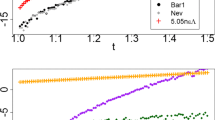Abstract
Extrapolation with a parallel splitting method is discussed. The parallel splitting method reduces a multidimensional problem into independent one-dimensional problems and can improve the convergence order of space variables to an order as high as the regularity of the solution permits. Therefore, in order to match the convergence order of the space variables, a high order method should also be used for the time integration. Second and third order extrapolation methods are used to improve the time convergence and it was found that the higher order extrapolation method can produce a more accurate solution than the lower order extrapolation method, but the convergence order of high order extrapolation may be less than the actual order of the extrapolation. We also try to show a fact that has not been studied in the literature, i.e. when the extrapolation is used, it may decrease the convergence of the space variables. The higher the order of the extrapolation method, the more it decreases the convergence of the space variables. The global extrapolation method also improves the parallel degree of the parallel splitting method. Numerical tests in the paper are done in a domain of a unit circle and a unit square.
Similar content being viewed by others
References
M.A. Cellia and G.F. Pinder, Generalized alternating direction collocation methods for parabolic equations, Numer. Meth. Part. Diff. Equat. 6 (1990) 193–246.
J.E. Dendy and G. Fairweather, Alternating direction Galerkin method for parabolic and hyperbolic problems on rectangular polygons, SIAM J. Numer. Anal. 12 (1975) 144–163.
J. Douglas Jr. and T. Dupont, Alternating direction Galerkin method on rectangles, in:Numerical Solution for Partial Differential Equations-II, ed. Hubbard (1971) pp. 133–214.
E.D. De Goede and J.H.M. Ten Thije Boonkkamp, Vectorization of the odd-even hopscotch scheme and the alternating direction implicit scheme for the two dimensional Burgers equations, SIAM J. Sci. Stat. Comput 11 (1990) 345–367.
S.-P. Han and G. Lou, A parallel algorithm for a class of convex programming, SIAM J. Contr. Optim. 26 (1988) 345–355.
S.L. Johnsson, Y. Saad and M.H. Schultz, Alternating direction methods on multiprocessor, SIAM J. Sci. Stat. Comput. 8 (1987) 686–770.
J.D. Lawson and J. Li. Morris, The extrapolation of first order methods for parabolic partial differential equations-I, SIAM J. Numer. Anal. 15 (1978), 1212–1224.
T. Lu, P. Neittaanmäki and X-C. Tai, A parallel splitting up method for partial differential equations and its application to Navier-Stokes equations, RAIRO Math. Model. Numer. Anal. 26 (1992).
T. Lu, P. Neittaanmäki and X-C. Tai, A parallel splitting up method and its application to Navier-Stokes equations Appl. Math. Lett. 4 (1991) 25–29.
G.I. Marchuk, Splitting and alternating direction methods, in:Handbook of Numerical Analysis, Vol. 1, eds. P.G. Ciarlet and J.L. Lions (North-Holland, 1990) pp. 197–465.
G.I. Marchuk and V.V. Shaidurov,Difference Methods and their Extrapolations (Springer, 1983).
D.A. Swayne, Time dependent boundary and interior forcing in locally one dimensional schemes, SIAM J. Sci. Stat. Comput. 8 (1987) 755–767.
X.-C. Tai, Parallel computing with splitting-up methods and the distributed parameter identification problems, Thesis, University of Jyväskylä, Department of Mathematics, Report 50 (1991).
X.-C. Tai and P. Neittaanmäki, Parallel finite element splitting-up method for paraboli problems, Numer. Meth. Part. Diff. Equat. 1 (1991) 209–225.
J.G. Verwer and H.B. De Vries, Global extrapolation of a first order splitting method, SIAM J. Sci. Stat. Comput. 6 (1985) 771–780.
Author information
Authors and Affiliations
Additional information
Supported by the Academy of Finland.
Rights and permissions
About this article
Cite this article
Tai, XC. Global extrapolation with a parallel splitting method. Numer Algor 3, 427–440 (1992). https://doi.org/10.1007/BF02141950
Issue Date:
DOI: https://doi.org/10.1007/BF02141950




